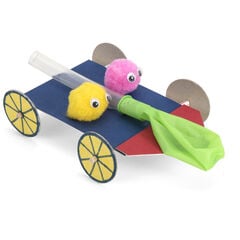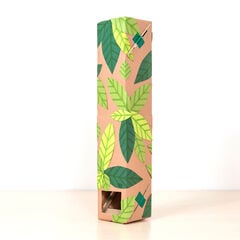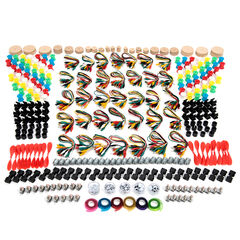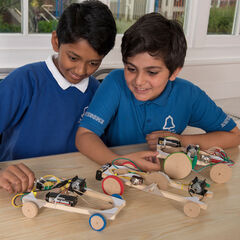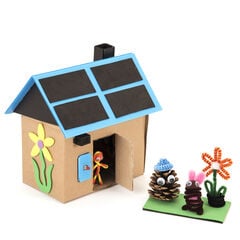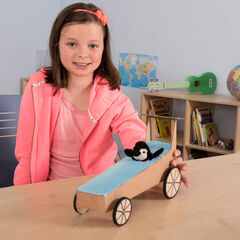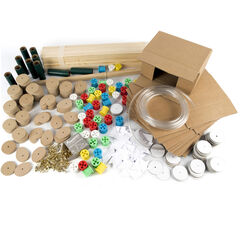Girls in Engineering
When I was little I used to love designing and making things. Then, when I got older, I had to work out what I would like to do as a career. I wanted something:
- creative
- practical
- useful to society
- enjoyable
- that I’d be good at
- with lots of good jobs to choose from
With this in mind I decided to study engineering, and then spent 24 years as a design and development engineer in industry. In those days not many girls went into engineering, so I was quite a novelty! After that I took a career break to spend more time with my children, and started using my skills and experience to enthuse the next generation about engineering.
Because engineering is not part of the curriculum, many children don’t really know what it is and how it applies to their everyday lives. As educationalist Iannis Miaoulis wrote ‘Students can spend weeks learning how a volcano works, and no time understanding how a car works. How often will they find themselves in a volcano?’
For the last ten years I have been developing the ‘Technology for Fun’ series of books and teacher resources for use in the classroom. This gives pupils a taste for what is involved in engineering and helps them develop useful skills, whilst showing them how the STEM subjects they learn in class are relevant and applied in practice. I find it difficult to explain to the students what engineering is, because there are so many different branches and options, so I prefer to give them the opportunity to experience the engineering design process for themselves.
There are many bespoke STEM kits available, but they can be very expensive, and because they do not use grass-roots components they can limit the children’s options in coming up with innovative designs, iterating and improving them.
For several years I have been working with TTS to develop fun STEM activities which appeal to both girls and boys. As a woman engineer I come from a different perspective – many STEM activities developed are just about competing! Although this can generate excitement (and allow you to compare the performance of different designs and measure the effect of your improvements), it does create more losers than winners. If you want to introduce competition it does not simply have to be “the fastest” – you could also celebrate other important attributes such as the most innovative, attractive or well-constructed design, most improved design or the best team-work.
I have tested my activities extensively in clubs and the classroom, so I can be sure they appeal to girls as well as boys. I relate the activities to real life applications where possible and make sure they are strong on creative content, as this is a crucial part of engineering which appeals to girls.
I feel strongly that it is important to introduce girls to engineering at primary age, before they pick up the message that it is ‘not for girls’, or start to make subject choices which could narrow down their options and eliminate it as a career.
Teachers, lawyers and doctors used to be nearly all men. Nowadays there are more women teachers and lawyers than men, and nearly half of doctors are women. I don’t see a good reason why engineering should be ‘not for girls’. Here are some women I know who have spent their whole careers in engineering:
Catherine, Project Manager, Landing Gear Systems in the aerospace industry:
‘I found it difficult to choose my A level subjects because I wasn’t sure what I wanted to do afterwards. I realised that what I enjoyed was understanding how things worked or were made, so that is how I chose engineering. This made me decide to take maths, physics and chemistry. The work in engineering is very varied and I enjoy working on products that improve people’s lives. Engineering is about being part of a team and I have worked with lots of interesting people.’
Rosie, Principal Marine Design Engineer:
‘I chose to go into engineering because I liked physics and maths best at school. Also, I liked the idea of showing people that girls can make their mark in what was then “a man’s world”. I have particularly enjoyed using my analytical skills to understand technical issues and coming up with creative solutions to engineering problems. It was always very satisfying to have found the solution. Making people’s lives better by the appliance of science.’
Carol, Safety Consulting Engineer, Crossrail:
‘My favourite subjects at A level were maths and physics, and I was not phased by the idea that only a small proportion of engineers were women. My dad was supportive and mum is delighted to boast about her engineer daughter! I’ve been in engineering for 35 years, mainly in the rail industry. I particularly enjoy working on major infrastructure projects in the UK and abroad, working alongside all disciplines overcoming technical problems. Although sometimes challenging, I have always enjoyed the interesting and varied work that comes with being an engineer.’
Sue, Nuclear Safety Manager, Rolls Royce:
‘I went to a mixed school and wanted to do technical drawing and metalwork, but girls weren’t allowed! So I didn’t know what engineering was about until a careers advisor suggested it; it sounded like the ideal career for me, as I liked the idea of applying my maths and physics. I’ve been lucky to have an engineering career in Rolls Royce for over 35 years, doing a wide variety of roles from design to development and hands-on maintenance inside nuclear submarines. It’s always amazing what a team of people can do to solve a problem, and it’s been fascinating to be part of something so important.’
These women have clearly had successful and satisfying careers in engineering. The aim of my work is to provide teachers with resources which help enthuse their pupils to be the next generation of girls (and boys) in engineering. Below are a selection of the STEM resources I have developed with TTS.
Fun, low cost STEM class kits suitable for 60 pupils working individually:
The Balloon buggies STEM class kit combines elements of science, technology and maths it is a useful vehicle for giving pupils a taste of engineering and helps them to understand how things work. It also demonstrates Isaac Newton’s third law of motion: “For every action there is an equal and opposite reaction.” View the How to blog post here.
The Periscopes STEM Class Kit is a cross-curricular STEM kit for 60 pupils to each make their own periscope and discover how it works. Children will investigate the way light behaves as it reflects down the periscope and then into their eye, and identify how each of the materials is used for a particular purpose.
Some exciting class kits incorporating electrical systems as part of the model include:
The Vibrating Brush Monsters, Fan Boats, Make your own Light and Fairground rides.
The Crumble Class Kit
This class kit allows you to design, build, wire-up and programme four different models, using a Crumble controller and a drag and drop programming language similar to Scratch:
The activity card sets each offer 10 STEM classroom activities with step by step instructions and encourage upcycling to keep costs down by using everyday ‘throwaway’ objects where possible:
The card sets include: STEM Activity Cards KS1/2, STEM Activity Cards KS2 and STEM Challenge Cards KS2.
With thanks to Caroline Alliston, Technology for Fun, for writing this blog.
Caroline Alliston, is a professional engineer and technical author with a degree from Cambridge and twenty four years experience in industry. Whilst on a career break to spend more time with her two boys, she started a club at their school to enthuse children about science and engineering. Before long there were more children on the waiting list than in the actual club!
Caroline now spends her time running hugely popular workshops for teachers, pupils, home educated children, holiday clubs, Scout groups etc. Unable to be in three places at once, she has written the Technology for Fun series of books incorporating her favourite and most successful projects, to give even more children the opportunity to have fun making things that really work.














